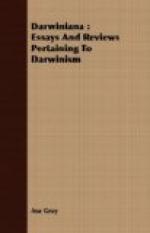can be shown that natural variation and natural selection
were capable of forming the crystalline lens, it will
not be denied that they were capable of forming the
iris, the sclerotica, the aqueous humors, or any and
all the other parts. Suppose, then, that we have
a number of animals, with eyes yet wanting the crystalline.
In this state the animals can see, but dimly and imperfectly,
as a man sees after having been couched. Some
of the offspring of these animals have, by natural
variation, merely a portion of the membrane which separates
the aqueous from the vitreous humor a little thickened
in its middle part, a little swelled out. This
refracts the light a little more than it would be
refracted by a membrane in which no such swelling existed,
and not only so, but, in combination with the humors,
it corrects the errors of dispersion and makes the
image somewhat more colorless. All the young animals
that have this swelled membrane see more distinctly
than their parents or brethren. They, therefore,
have an advantage over them in the struggle for life.
They can obtain food more easily; can find their prey,
and escape from their enemies with greater facility
than their kindred. This thickening and rounding
of the membrane goes on from generation to generation
by natural variation; natural selection all the while
“picking out with unerring skill all the improvements,
through countless generations,” until at length
it is found that the membrane has become a perfect
crystalline lens. Now, where is the design in
all this? The membrane was not thickened and
rounded to the end that the image should be more distinct
and colorless; but, being thickened and rounded by
the operation of natural variation, inherent in generation,
natural selection of necessity produced the result
that we have seen. The same result was thus produced
of necessity, in the eye, that Dollond came at, in
the telescope, with design, through painful guessing,
reasoning, experimenting, and forming.
Suppose our skeptic to believe in all this power of
natural selection; will he now seal up his verdict
for design, with the same confidence that he would
before he heard of Darwin? If not, then “the
supposed proof from design is invalidated by Darwin’s
theory.”
A.G.—Waiving incidental points and looking
only to the gist of the question, I remark that the
argument for design as against chance, in the formation
of the eye, is most convincingly stated in your argument.
Upon this and upon numerous similar arguments the
whole question we are discussing turns. So, if
the skeptic was about to seal his verdict in favor
of design, and a designer, when Darwin’s book
appeared, why should his verdict now be changed or
withheld? All the facts about the eye, which
convinced him that the organ was designed, remain just
as they were. His conviction was not produced
through testimony or eyewitness, but design was irresistibly
inferred from the evidence of contrivance in the eye
itself.




